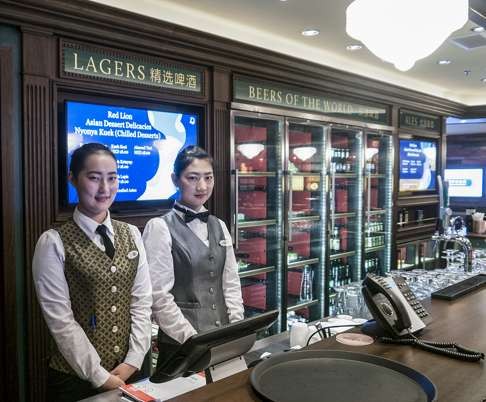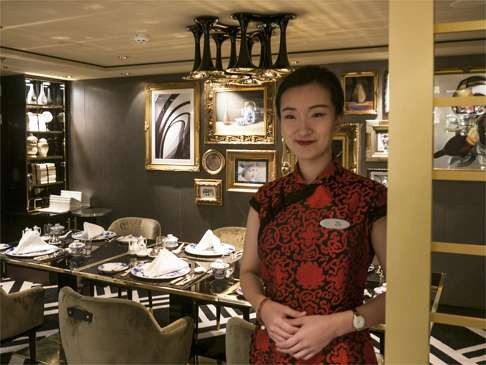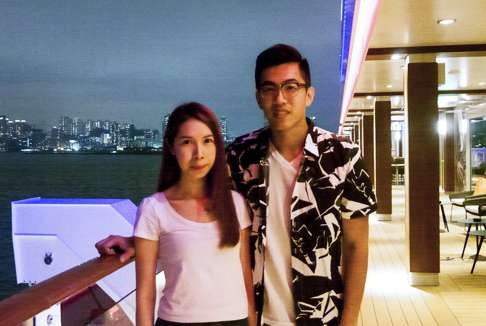
What it's like to sail aboard Hong Kong-based luxury cruise liner the Genting Dream
Every conceivable luxury awaits you aboard HK$10 billion, 18-storey vessel, but city needs better infrastructure to benefit from expected Pearl River Delta cruise boom
An impeccably dressed Ukrainian butler called Yanislav conducts a private tour of the comfortably appointed stateroom on board Asia’s first luxury cruise liner, as it departs on its inaugural voyage.
The new 335-metre Genting Dream is making a night-time departure from Kai Tak Cruise Terminal bound for Vietnam via Guangzhou, and as Yanislav slides open the French doors to the spacious private balcony, the illuminated Hong Kong skyline can be seen slipping past.

This palatial 151,000-tonne vessel, built at the Lloyd Werft shipyard in Bremerhaven, Germany, offers passengers every conceivable on-board facility, from the Johnnie Walker whisky house to two submersibles able to take them under the South China Sea.
Luxury liner unveiled at Hong Kong’s Victoria Harbour
For those wanting the best, two “Garden Penthouses” feature original contemporary artwork, a whirlpool spa, sauna, private sun deck and grand piano.


As the massive vessel squeezes through the narrow Lei Yue Mun gap, at the eastern exit from Hong Kong harbour, it’s apparent that no expense has been spared.
On deck seven, a traditional English pub called (predictably, perhaps) the Red Lion is located opposite the mahjong room. Five private karaoke rooms are not far from a high-end art gallery, and the extensive duty-free boutique, selling designer watches and handbags, leads to an Australian-style celebrity chef eatery, Bistro by Mark Best. There’s both an Eastern- and a Western-style luxury spa. It’s the floating entertainment equivalent of those lavish buffet breakfasts in five-star international hotels, where guests end up eating fried bacon with congee and a Danish pastry.
Cruising the Med aboard ‘the most luxurious ship ever built’
Genting Dream is more evidence that the cruise business is booming in Asia. Hongkongers love it and China is seen as the fastest growing cruise market in the world, forecast to become the second largest behind the US by next year.

Hong Kong is regarded as a key part of the picture by these big cruise operators, who see 100 million potential cruisers located within a two-hour drive of the city, but there have been grumbles that local infrastructure needs urgently updating. Despite the HK$10 billion invested by Genting in its new ship, the only way to reach it at the Kai Tak Cruise Terminal is via taxi or a bumpy minibus from Kowloon Bay MTR station. Otherwise it’s a courtesy coach from Diamond Hill MTR station.
It’s hardly the maritime equivalent of the Airport Express, and with more big lines looking to home-port in Hong Kong, the cruising boom needs better connections to the rest of the city, so more local businesses can benefit from it.

Despite the frustration, the established names in cruising, such as Royal Caribbean and Carnival, view Hong Kong as key to their success and would also concede that Asian cruising was pioneered here.
In 1993, the Malaysian leisure multinational Genting formed Star Cruises and what started as a relatively modest offering of two Swedish cruise ferries, obtained after a bankruptcy, is now the third-largest cruise operator in the world. Genting Hong Kong has added Crystal Cruises and now Dream Cruises to its portfolio as it responds to local demand for more sophisticated and luxurious offerings.
Overall in Asia, 40 per cent of cruisers are under 40 and I suspect it is even younger in Hong Kong
Although well-established Western cruise lines might once have looked down their noses at a Hong Kong brand known for its cheap and cheerful casino cruises, they are now desperately seeking a toehold in the Asian market, while Genting has been doing it very successfully for 23 years.

Asian cruising challenges some of the traditional stereotypes associated with the Western traditions of long voyages to romantic destinations, such as lavish dining at the captain’s table and snoozing quietly in a deckchair. Asian cruises are typically shorter, happen closer to home and are as much about the on-board action as the exotic destinations. They are aimed at three generations of the same family holidaying together and, these days are just as likely to include highbrow lectures from university professors as 24-hour gambling in dimly lit casinos. And while the profile of the typical Western cruiser might be a well-to-do retired couple in their 60s or 70s, Bent believes local cruisers have a very different profile.
“Overall in Asia, 40 per cent of cruisers are under 40 and I suspect it is even younger in Hong Kong, where there is also a multigenerational aspect,” he says, and it was certainly a younger, energetic crowd on board last month for the inaugural cruise of the ship, which also boasts its own Zouk nightclub.

“For me the swimming pool on the top deck is really impressive,” she says, referring to the large open-air pool with a jacuzzi located at each corner, where passengers soak gently while listening to a live Canto-pop band performing on the adjacent stage.
Despite all the impressive cosmopolitan opulence and sophistication, Genting has clearly not forsaken its roots, and by 10pm most of the passengers can be found in the spacious casino.
While some are enjoying an American female vocalist’s rendition of I’ve Got a Brand New Pair of Roller Skates, a group of elderly ladies dressed as though for an early start at Wan Chai wet market order complimentary bottles of water and head for the banks of blinking electronic gaming machines. Heads turn as a loud collective roar of disappointment erupts from a large party of men who are obviously not faring too well at the blackjack table (minimum stake HK$1,000).
For those not drinking, eating, sleeping or gambling (the most popular on-board pastimes by far), there is no shortage of healthy pursuits. Included are a state-of-the-art gymnasium, where a personal trainer looks eager to lick anyone into shape for a morning of water-sliding, mini-golf, rock climbing, swimming or a workout on the challenging ropes course. There’s no chance of being run over on the jogging track, either, but rather like the lifeboats, it’s reassuring to know it’s there if it’s needed.
Hopefully, the city might eventually wake up to the significant economic opportunities being created by a maritime tourism boom that was largely made in Hong Kong.

